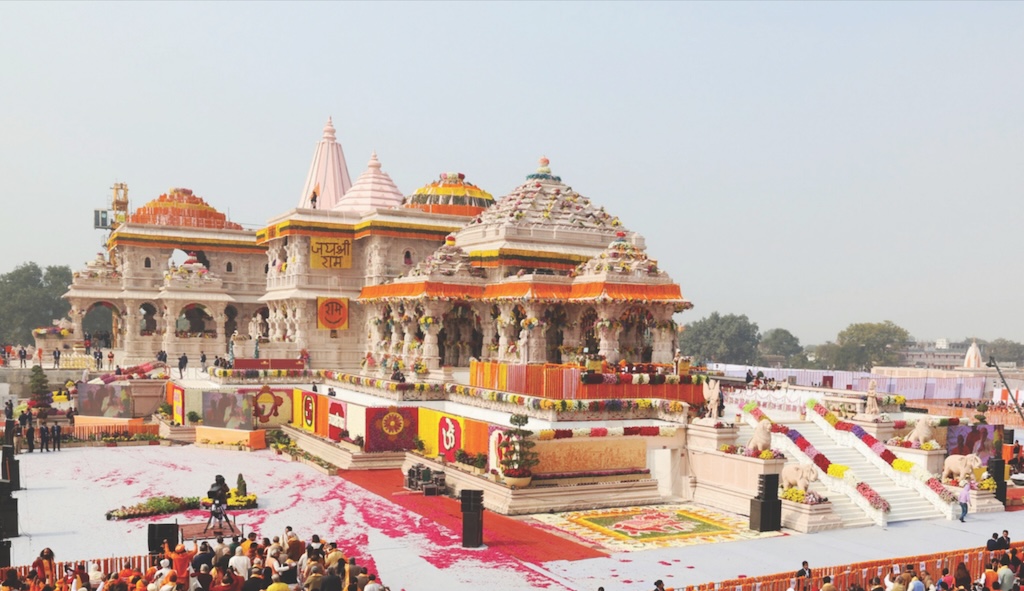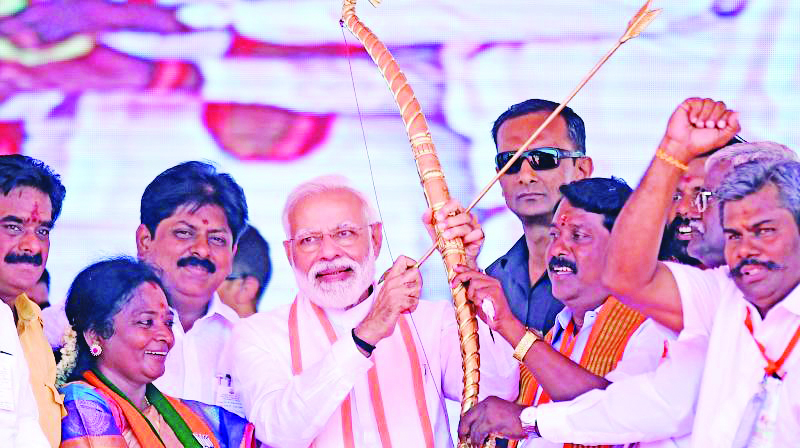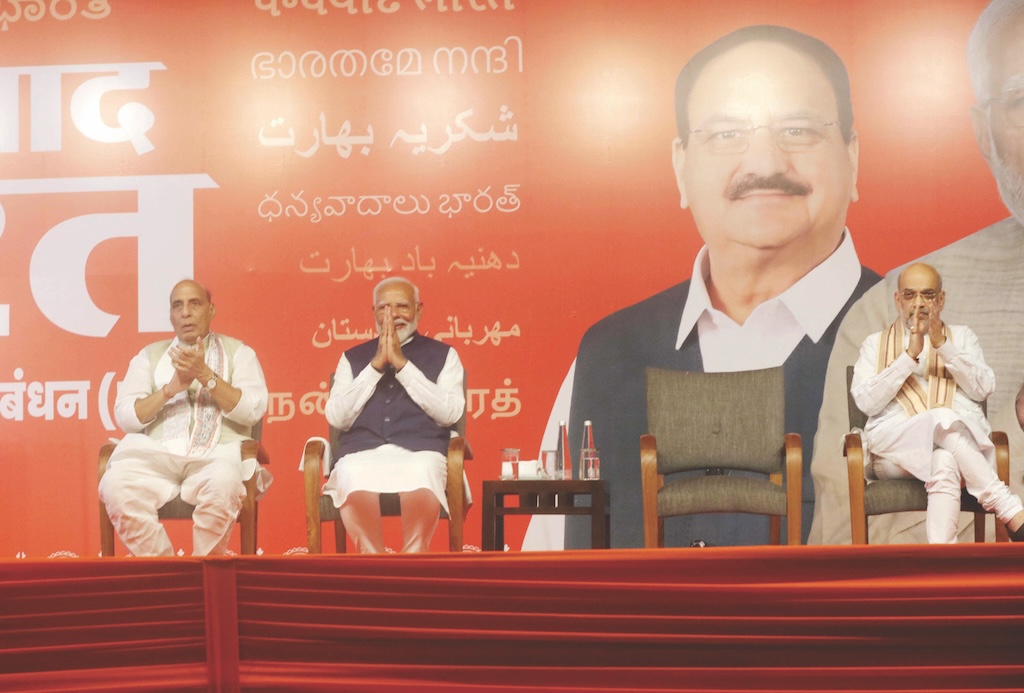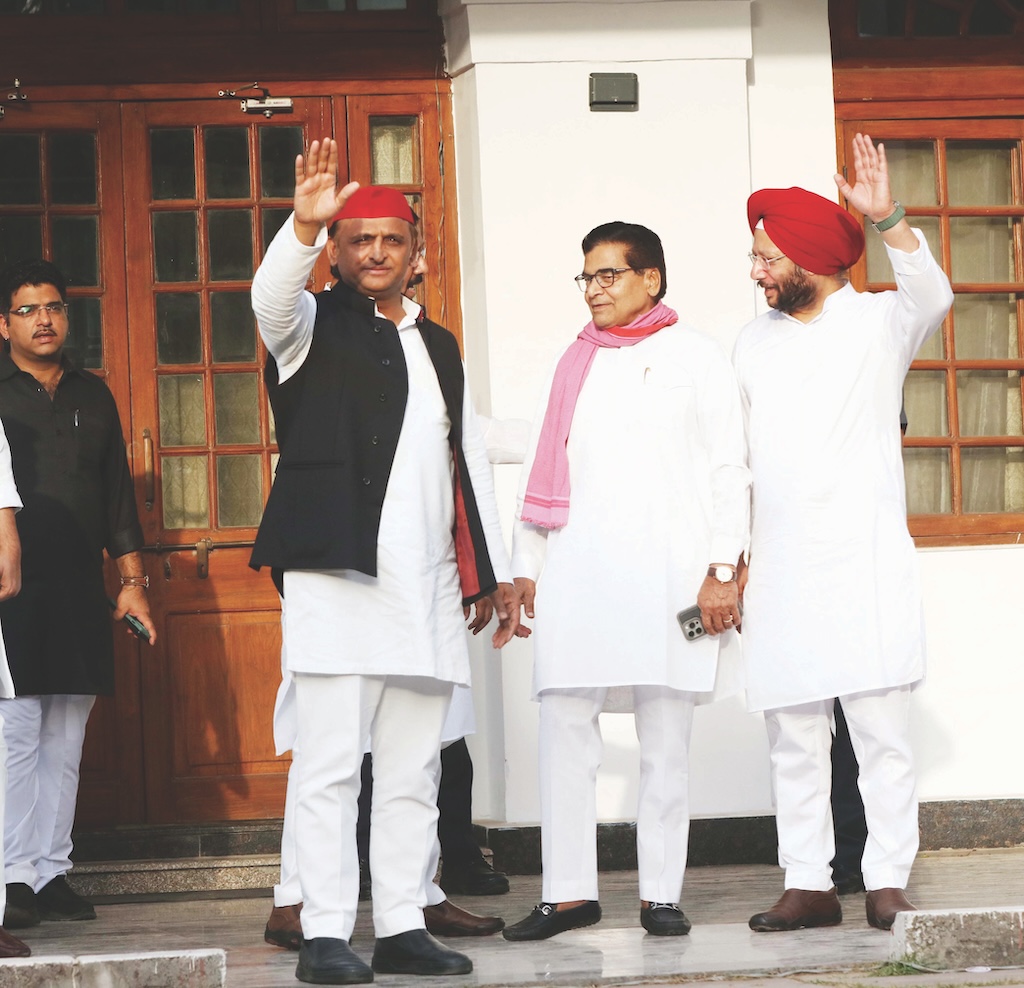The era of coalition government returns, as was the norm before 2014. Modi, accustomed to ruling with a full majority, must now involve influential allies like Naidu and Nitish. This marks a shift from ‘Modi government’ to ‘NDA government’
By Reeta Singh
- It became clear from the mandate that this is not a clear victory for BJP but it is more a victory for NDA
- Modi was compelled to shift his narrative due to the electoral issues raised by the main opposition alliance – INDIA
- BJP and RSS’s electoral strategies failed to detect the undercurrent of support for the PDA and INDIA alliance in UP
- In the midst of elections, the ECI found itself under intense scrutiny as political parties raised questions about its impartiality
SPEAKING on the motion of thanks on the President’s address in the Lok Sabha on 5 February 2024, Prime Minister Narendra Modi said, “Mr. Speaker, Only 100-125 days remain to go. I don’t go into numbers, but I can see the mood of the country. It will make the NDA cross 400, and the BJP will definitely get 370 seats…” But when the mandate came on 4 June, the NDA was reduced to 292 seats and BJP, which had contested the elections in the name of ‘Modi ki Guarantee’, was reduced to 240 seats, which resulted in a loss of 63 seats compared to 2019. This means that BJP could not even cross the 250 mark. This mandate made it clear that BJP will not be able to work on the basis of Modi’s face alone. The mandate also made it clear that ‘mere rhetoric and promises will not work, MPs will also have to do their work.’ Whereas the main opposition party Congress got 99 seats and gained 47 seats from the 2019 elections.
It became clear from the mandate that this is not a clear victory for BJP but it is more a victory for NDA. The interesting thing is that Modi is going to form the government at the Center for the third time and he does not like anyone’s interference, nor does he give accountability to anyone. But, now he has to spend a full five years with Nitish Kumar and Chandrababu Naidu. Anyway, Nitish Kumar and Chandrababu too parted ways with BJP previously.
CHANGING POLITICAL NARRATIVES
Modi was compelled to shift his narrative due to the electoral issues like unemployment, inflation, electoral bonds, caste census, reservation, and MSP for farmers raised by the main opposition alliance – INDIA. In the later stages, the PM refrained from discussing the Ram Mandir, Modi’s guarantee, or development he has achieved in the country over the past ten years. His speeches focused on the Congress manifesto and the ‘two shehzadas – Rahul Gandhi and Akhilesh Yadav.’ As the election progressed Modi’s rhetoric moved to phrases like ‘Mangalsutra’ ‘Mutton’ ‘Babri locks’ and Hindu-Muslim relations. Although Modi did not address women’s safety or the allegations of sexual exploitation against Prajwal Revanna.
The BJP’s manifesto, titled ‘Modi’s Guarantee,’ concentrated on four classes – the Poor, the Youth, the Farmers, and the Women, whom Modi referred to as ‘the four castes of India.’ Modi emphasised providing free rations to 80 crore Indians for five years, as well as free healthcare through schemes like Ayushman Bharat, and housing and cooking gas through the PM Awas Yojana and Ujjwala Yojana, respectively.
However, public opinion was different. The opinion of people was, ‘there is free electricity and water, but there is no employment, so these free schemes cannot change the direction of the future unless there is employment’, which resulted in BJP’s seats reduction.
BJP tried its best to capitalise on Modi’s ‘Vishwa Guru’ image in the elections in which claims were made that the PM spoke to Israeli PM Netanyahu regarding Israel not to attack Gaza during the month of Ramzan. BJP also tried to raise the issue of Pakistan during the elections which completely failed. Voters were neither interested in making PoK a part of India nor in Pakistan.

In his speech in Banswara, during campaigning on April 21, Rajasthan, PM Modi alleged that “The Congress if voted to power would distribute the country’s wealth to those who have more children.” This statement of Modi in a sensitive state like Rajasthan was a complete attempt to polarise his voters. BJP’s voters remain united and the voting shift to Hindu vs Muslim. Due to which BJP had to suffer the loss not only in Rajasthan but also in UP.
Voters exhibited disapproval towards the ambitious promise of revitalising Ayodhya into a ‘global city’ at a staggering cost of Rs 10,000 crore. This sentiment manifested in the electoral defeat of the BJP in the Faizabad seat
In January, the nationwide and global spotlight shone on the consecration of the Ram Temple under Prime Minister Modi’s leadership. Both the BJP and the Sangh were buoyant, anticipating electoral gains starting from April, buoyed by this development. However, despite this fervour, voters exhibited disapproval towards the ambitious promise of revitalising Ayodhya into a ‘global city’ at a staggering cost of Rs 10,000 crore. This sentiment manifested in the electoral defeat of the BJP in the Faizabad seat by a margin exceeding 50 thousand votes on June 4.
FAVOURITISM OF MEDIA
The 2024 Lok Sabha election outcome underscores a shift in the impact of media narratives and electoral spending on voter behaviour. Despite the fervent promotion of ‘Modi magic’ by the ‘godi media’ and substantial investments in advertisements and social media campaigns by the BJP, the electoral sway witnessed in 2014 and 2019 was notably diminished. Modi’s long standing ambition of achieving a Congress-free India, which gained traction post-2014, remains unattained.
Reflecting on the electoral trajectory, Modi’s BJP secured a resounding victory in 2014, clinching 282 seats while relegating the Congress to a mere 44 seats, stripping it of its main opposition status. However, in 2019, despite Modi’s critique of Congress’s dynastic politics, the BJP’s seat count marginally increased to 303, while the Congress managed to augment its tally from 44 to 52 seats.
Despite sustained attacks on Rahul Gandhi by Modi and BJP, and their media allies, Gandhi has exhibited signs of growth and evolution. This electoral landscape indicates a nuanced political scenario where Modi’s vision faces challenges in materialising, despite his prolonged pursuit of a Congress-free India.
Rahul Gandhi’s efforts in 2019 were substantial, yet they did not yield success. In 2024, Modi accused the Congress of nepotism, corruption, and Muslim appeasement, but this time the voters’ confidence in the Congress increased, and their seat count rose to 99.
At a rally in Delhi, Modi charged that ‘four generations of Congress have ruled Delhi, but today they lack the strength to contest even four seats. The Congress is not even fighting in their stronghold—10 Janpath. The Congress prince wants to scrutinise your property and allocate half to their vote bank, a practice they have continued for years.’
Despite the public’s growing indifference to Modi’s speeches and slogans, he received unwavering support from the ‘godi media’ and the biassed policies of Election Commission. Furthermore, the exit polls, which largely predicted over 400 seats for the BJP and NDA, have been questioned for their credibility.
SETBACK IN UTTAR PRADESH
The BJP’s ‘double engine’ government suffered a significant setback in Uttar Pradesh, where neither Modi-Yogi’s appeal nor Amit Shah’s activism proved effective. The BJP, considering Uttar Pradesh (UP) as its stronghold, aimed to win over 70 seats, especially following the consecration of Lord Ram in Ayodhya. However, the BJP and RSS’s electoral strategies failed to detect the undercurrent of support for the PDA (Pichre Dalit Alpashankhak) and INDIA alliance in UP.
BJP candidates proclaimed that the NDA would win over 400 seats, but Rahul Gandhi and Akhilesh Yadav exposed the motive behind this claim, convincing the public that it was a precursor to constitutional changes and the end of reservations for backward castes. Additionally, the Congress’s manifesto pledge to provide Rs 8500 monthly to impoverished women contributed to the BJP’s losses.
In Uttar Pradesh, the NDA exerted its full strength; nearly all Central ministers were assigned responsibilities in Modi’s constituency—Varanasi. Despite these efforts, Modi at one point trailed behind the Congress candidate Ajay Rai in the vote count. Modi was expecting to win by more than 5 lakh votes from Varanasi but he could win by only 1.5 lakh votes.

PM Modi mentioned Ram Mandir 11 times and did not mention Rahul Gandhi by his name even once, whereas Rahul Gandhi did not mention Ram Mandir even once in the 50 days of campaigning however, he mentioned Modi 45 times
The condition of BJP in UP can be known from the fact that ten Union ministers contested, with seven facing defeat. The losses included Smriti Irani in Amethi (by 1.67 lakh votes), Mahendra Nath Pandey in Chandauli (21,565 votes), Sanjeev Balyan in Muzaffarnagar (24,672 votes), Ajay Mishra Teni in Lakhimpur Kheri (34,329 votes), Sadhvi Niranjan Jyoti in Fatehpur (33,199 votes), Kaushal Kishore in the Mohanlalganj SC reserved seat (70,292 votes), and Bhanu Pratap Singh Verma in the Jalaun SC reserved seat (53,898 votes). Additionally, two ministers in the UP government lost their seats: Dinesh Pratap Singh, who was defeated by Congress leader Rahul Gandhi in Rae Bareli by over 3.90 lakh votes, and Jai Veer Singh, who lost to SP leader Dimple Yadav in Mainpuri by over 2.21 lakh votes.
RAHUL GANDHI OUTSHINES MODI ON SOCIAL MEDIA
WHETHER it’s traditional media or social media, India’s Prime Minister Narendra Modi is the most followed politician in the world. Even on platforms like X (formerly Twitter), he holds a prominent position after the former US President Barack Obama. On Facebook, Instagram, and YouTube, Narendra Modi has more than 26 crore followers. While print and TV media often seem to favour Modi, positioning him as their favourite and dominant figure, the 2024 Lok Sabha elections saw a different story unfold on social media. Congress leader Rahul Gandhi emerged victorious on this digital front, making a significant impact and challenging Modi’s dominance.
If we look at the posts and likes of Modi and Rahul Gandhi on social media from April 1 to May 20 during the election campaign, Rahul Gandhi was ahead of Modi. During the last 50 days, PM Modi made 1,159 posts, while Rahul Gandhi made a total of 120 posts. Interestingly, Modi received an average of 17,000 likes per post, whereas Rahul Gandhi received 38,000 likes per post. Rahul Gandhi’s repost rate was nearly three times higher than Modi’s. If we look at these posts, PM Modi mentioned Ram Mandir 11 times and did not mention Rahul Gandhi by his name even once, whereas Rahul Gandhi did not mention Ram Mandir even once in the 50 days of campaigning however, he mentioned Modi 45 times. On Instagram, Prime Minister Modi’s followers grew from 8.82 crore on April 4th to 8.92 crore by May 20th. In contrast, Rahul Gandhi’s Instagram followers doubled from 64.28 lakh to 81.86 lakh.

Turning to YouTube, Narendra Modi’s channel saw an increase in followers from 2.27 crore on April 4th to 2.35 crore over the next 50 days, with total views reaching 26.28 crore. Meanwhile, Rahul Gandhi’s YouTube followers rose from 40.7 lakh to 59.3 lakh, and his total views soared to 47.83 crore, which is twice the number of views PM Modi received, along with an increase of 11 lakh followers.
However, on Facebook, PM Modi maintained a lead over Rahul Gandhi. Modi’s followers marginally increased from 4.93 crore to 4.94 crore, and he received 1.10 lakh likes. Rahul Gandhi’s followers grew from 69.6 lakh to 70.25 lakh, with 62 thousand likes.
Between April 1 and May 20, PM Modi rarely addressed certain critical issues on social media platforms. He seldom posted about ‘reservations’ and ‘farmers’, while avoiding topics like ‘inflation’ and ‘unemployment’. In contrast, Rahul Gandhi actively engaged with issues such as ‘reservations’, ‘inflation’, ‘unemployment’, ‘agniveers’, and ‘farmers’. Modi made approx 1159 posts during this 50-day period, mentioning Congress 200 times. In 120 posts, Rahul Gandhi mentioned the BJP 22 times and Modi 45 times. Without naming Rahul, Modi referred to him as ‘Shahzada’ in his posts and rallies.
However, Rahul Gandhi’s popularity among the youth was evident on Instagram, where his followers increased rapidly. In the 50-day election period, Modi gained 954,000 followers, while Rahul gained 1.757 million followers. From April 21 to May 22, Rahul received 210 million more views on YouTube compared to Modi. These statistics indicate that Rahul Gandhi’s posts received more engagement, likes, and comments than those of PM Modi.
SOCIAL AND CASTE DYNAMICS
The effect of the Jat movement was also seen in Western UP, where Jats seemed to be angry with BJP. Although to appease the Jats, Modi posthumously awarded the Bharat Ratna to Chaudhary Charan Singh and included his grandson Jayant Chaudhary’s party, Rashtriya Lok Dal, in the NDA, this did not yield any significant benefit. Modi-led BJP tried to woo the villagers and farmers by telling them that Congress would take away one of their two buffaloes. BJP was also considering it a success to some extent by scaring the people with the claim that if Congress comes to power, Sharia law will be implemented and the rights of OBCs will be taken away and given to Muslims.

Despite the fervent promotion of ‘Modi magic’ by the ‘godi media’ and substantial investments in advertisements and social media campaigns by the BJP, the electoral sway witnessed in 2014 and 2019 was notably diminished
On the other hand, Rahul Gandhi kept trying to convince the people that if the INDIA Alliance forms the government, women will receive Rs 1 lakh annually in their bank accounts, the youth will get employment, and the Agniveer Yojana will be abolished. By the time the last phase of the election came, Modi began to be projected as an ‘Avatar Purush’ by the BJP, blind followers, and pro-government media. But in UP, BJP was reduced to 33 seats, and BSP, often considered a vote-cutter for BJP and referred to as BJP’s ‘B’ party, was completely wiped out.
Modi and BJP thought that the issue of Hindutva alone would work in UP and that there is no one else who can stand against Hindutva. Secondly, Mayawati’s devoted Dalit voters dispelled the misconception that Dalits are not her bonded labourers. Mayawati’s decision to remove her nephew in the middle of the election also sent the wrong message. To weaken the hold of Yogi and Modi, Akhilesh Yadav also showed wisdom in ticket distribution, fielding only 5 Yadav candidates from his family on 62 seats while taking full care of non-Yadav castes.
Controversies Surrounding Election Commission
IN the midst of the 2024 former Election Commissioners elections, the Election Commission found itself under intense scrutiny as political parties raised questions about its impartiality. Accusations of bias against the constitutional institution surfaced for the first time, with the opposition pointing out instances where the Commission remained silent on statements made by the ruling party, particularly regarding religious appeals. Notably, Congress President Mallikarjun Kharge voiced concerns about delays in releasing voting percentage data, prompting a rebuttal from the Election Commission dismissing the allegations as baseless and aimed at fostering a biased narrative.

Of particular concern was the discrepancy in voting data between the initial and final figures released by the Commission, leading to allegations of manipulation. The opposition, citing data discrepancies, highlighted the states where the BJP might lose significant seats. However, Prime Minister Narendra Modi dismissed concerns, asserting the Commission’s independence and insinuating biases from aligned with the Congress ideology.
A significant point of contention revolved around Form 17C, which records polling booth voting information. Opposition parties demanded transparency through the scanning and uploading of Form 17C on the Commission’s website, a move contested by the Election Commission citing potential confusion in the election process. Additionally, the Election Commission held a press conference, a departure from past practices, to address allegations of irregularities and reaffirm the integrity of the electoral process. Chief Election Commissioner Rajiv Kumar refuted claims of coercion and irregularities, maintaining the Commission’s neutrality.
Despite these responses, allegations of collaboration between the BJP and the Election Commission persisted among opposition parties, underscoring the contentious nature of the electoral process and the role of regulatory bodies.
SOCIAL ENGINEERING
The SP, traditionally considered a Yadav and Muslim centric party, gave 26 out of 63 tickets to non-Yadav backward communities in UP with nominees hailing from Kurmis, an influential non-Yadav OBC social group getting nine tickets, the Nishad community getting four tickets and the Kushwaha, Maurya, and Shakya communities getting six tickets. In Purvanchal, out of 27 seats, the Nishad community got two tickets, while communities like Kurmi, Kushawaha, Shakya, and Rajbhar were given 13 tickets. It paid off with 11 candidates from these social segments emerging victorious in Purvanchal.
Akhilesh changed the entire equation by fielding a Dalit candidate on the Faizabad-Ayodhya seat, leading to BJP’s loss in Ayodhya-Faizabad as well as the surrounding seats. SP won 37 out of 62 seats, while Congress, fielding candidates on 17 seats, won 6.
The India Alliance was successful in convincing the voters in UP, especially Dalits and backward castes, that if Modi becomes strong, the Constitution will be in danger and BJP could end reservation. As a result, Mayawati’s Jatav voters also turned to SP-Congress.
The mandate of 2024 has made it clear that after this election, Mayawati has been marginalised, and in her place, Chandrashekhar has emerged as an alternative, having secured victory in Nagina.
ROAD AHEAD FOR MODI AND BJP
The ruling party did not contest the 2024 elections alone; it had the support of the Election Commission, ED, and CBI. The Election Commission appeared biassed, frequently targeting the opposition after the election process started in April. For instance, when Congress complained about Modi’s communal statements, the BJP quickly countered with attacks on Rahul Gandhi. Moreover, despite Chief Election Commissioner Rajiv Kumar’s call for restrained speeches, Modi used derogatory language the very next day. The Commission failed to act promptly on Modi’s inflammatory speech in Banswara, which included anti-Muslim rhetoric, only sending a notice to BJP President JP Nadda four days later. In contrast, AAP’s Atishi received an immediate notice when she alleged that a senior BJP leader tried to lure her into the party.

To weaken the hold of Yogi and Modi, Akhilesh Yadav also showed wisdom in ticket distribution, fielding only 5 Yadav candidates from his family on 62 seats while taking full care of non-Yadav castes
Even though Modi has secured a third term as Prime Minister, Bihar Chief Minister Nitish Kumar has become a necessity for him, with no assurance of his loyalty. Additionally, N. Chandrababu Naidu and his party TDP will also not be easy alliance partners for the Modi government.
![]()
